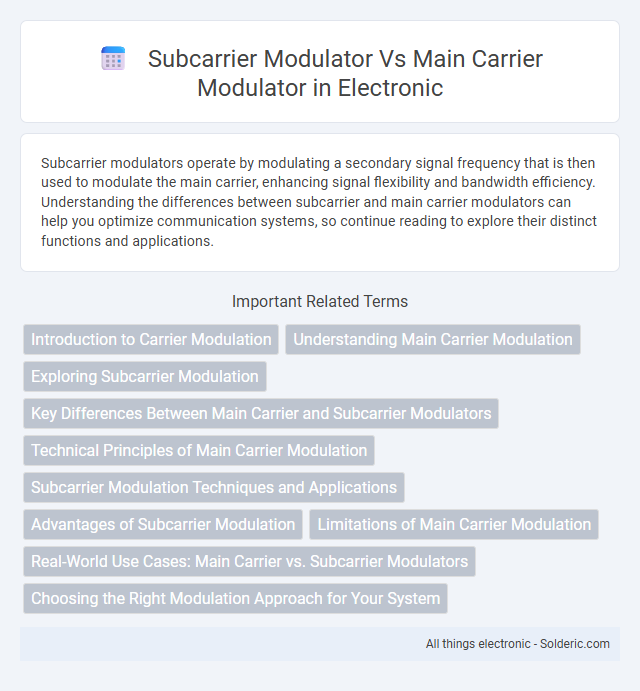Subcarrier modulators operate by modulating a secondary signal frequency that is then used to modulate the main carrier, enhancing signal flexibility and bandwidth efficiency. Understanding the differences between subcarrier and main carrier modulators can help you optimize communication systems, so continue reading to explore their distinct functions and applications.
Comparison Table
| Feature | Subcarrier Modulator | Main Carrier Modulator |
|---|---|---|
| Function | Modulates a subcarrier signal embedded within the main carrier | Modulates the primary carrier signal for transmission |
| Frequency Range | Operates at a higher frequency than baseband but lower than main carrier | Operates at the fundamental transmission carrier frequency |
| Purpose | Enables multiplexing or modulation of multiple signals on one main carrier | Transmits the main information signal to the receiver |
| Complexity | Moderate complexity due to additional frequency conversion | Less complex as it directly modulates the main carrier |
| Application | Used in TV broadcasting, FM stereo, and composite signals | Common in amplitude, frequency, and phase modulation systems |
Introduction to Carrier Modulation
Carrier modulation transforms baseband signals into higher frequency bands for efficient transmission, using both main and subcarrier modulators. The main carrier modulator shifts the entire signal spectrum to a primary carrier frequency, essential for long-distance communication and bandwidth allocation. Subcarrier modulators embed additional information onto a secondary frequency within the main carrier, enabling multiplexing and enhancing channel capacity in complex communication systems.
Understanding Main Carrier Modulation
Main carrier modulation involves varying the amplitude, frequency, or phase of the primary carrier signal to encode information for transmission. It serves as the fundamental method for signal representation in communication systems, defining the main frequency band for data delivery. Understanding main carrier modulation is essential for optimizing bandwidth efficiency and signal integrity in wireless and wired communication networks.
Exploring Subcarrier Modulation
Subcarrier modulation involves embedding a lower-frequency subcarrier signal onto the main carrier wave, enabling efficient transmission of multiple signals or types of information simultaneously. This technique enhances bandwidth utilization and reduces interference, making subcarrier modulators essential in communication systems such as FM broadcasting and satellite transmissions. Understanding the distinction between subcarrier modulators and main carrier modulators helps you optimize signal clarity and system performance in complex transmission environments.
Key Differences Between Main Carrier and Subcarrier Modulators
Main carrier modulators directly modulate the primary RF carrier signal, affecting characteristics such as amplitude, frequency, or phase of the main carrier wave, while subcarrier modulators modulate an intermediate frequency signal that is subsequently used to modulate the main carrier. Subcarrier modulation enables multiplexing and transmission of multiple signals within the same main carrier by embedding lower frequency signals onto the subcarrier before upconversion. The key difference lies in their modulation points and functional roles: main carrier modulation impacts the primary transmission frequency signal, whereas subcarrier modulation manipulates auxiliary signals to facilitate complex transmission schemes like FM stereo and digital TV broadcasting.
Technical Principles of Main Carrier Modulation
Main carrier modulation operates by varying the amplitude, frequency, or phase of the primary carrier wave to encode information efficiently for transmission. Techniques such as amplitude modulation (AM), frequency modulation (FM), and phase modulation (PM) form the core technical principles, ensuring robust signal integrity and bandwidth optimization. Your communication system relies on precise main carrier modulation to maintain signal clarity and resist interference over various transmission channels.
Subcarrier Modulation Techniques and Applications
Subcarrier modulation techniques involve modulating a baseband signal onto a subcarrier frequency before combining it with the main carrier, enabling efficient multiplexing and improved signal separation in communication systems. Common subcarrier modulation methods include Amplitude Modulation (AM), Frequency Modulation (FM), and Phase Modulation (PM), which are widely used in analog TV broadcasting, FM stereo radio, and optical communication. These techniques facilitate simultaneous transmission of multiple signals while minimizing interference, making them essential for complex signal environments and advanced wireless networks.
Advantages of Subcarrier Modulation
Subcarrier modulation offers enhanced signal separation by transmitting multiple signals on different subcarrier frequencies, reducing interference and improving bandwidth efficiency. It allows for easier demodulation and better noise immunity compared to main carrier modulation, making it ideal for complex communication systems. Your system can benefit from increased flexibility and the ability to multiplex various data streams simultaneously using subcarrier modulation techniques.
Limitations of Main Carrier Modulation
Main carrier modulation is limited by its susceptibility to noise and interference, which can degrade signal quality and reduce data transmission reliability. It often requires higher power consumption and bandwidth, making it less efficient for complex or high-capacity communication systems. These limitations highlight the need for subcarrier modulation to improve spectral efficiency and enhance signal robustness in modern telecommunications.
Real-World Use Cases: Main Carrier vs. Subcarrier Modulators
Main carrier modulators are widely used in primary broadcast transmissions, such as AM/FM radio and television signals, ensuring robust and direct signal delivery across broad areas. Subcarrier modulators find key applications in specialized communication systems like FM stereo broadcasting and broadcast auxiliary services, providing additional data channels without interfering with the main carrier signal. Your choice between main carrier and subcarrier modulators depends on whether you require a primary transmission channel or supplementary data embedding within existing broadcasts.
Choosing the Right Modulation Approach for Your System
Choosing the right modulation approach depends on your system requirements, including bandwidth efficiency and signal robustness. A subcarrier modulator offers better separation of signals by modulating information onto a secondary carrier, ideal for complex multiplexing scenarios, while a main carrier modulator directly modulates the primary carrier frequency, providing simplicity and lower latency. Understanding your system's data rate, interference environment, and hardware capabilities will guide you in selecting the optimal modulation technique.
Subcarrier modulator vs main carrier modulator Infographic

 solderic.com
solderic.com